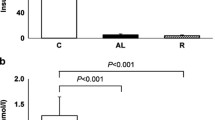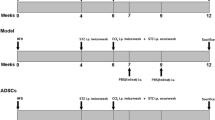Abstract
C-peptide is gaining much interest recently due to its well-documented beneficial effects on multiple organ dysfunction induced by diabetes. Our study was designed to investigate the effect of C-peptide on hepatocellular dysfunction in diabetic rats. Wistar male rats were separated into four groups: control, diabetic, diabetic + insulin, and diabetic + C-peptide. Serum levels of glucose, insulin, and liver biomarkers were assessed. Liver sections were collected for histopathological examination and immuno-histochemical assessment of tumor necrosis factor alpha (TNF-α). Oxidative stress markers and gene expression of inducible nitric oxide synthase (iNOS), transforming growth factor beta 1 (TGF-β1), and glucose-6-phosphatase (G6Pase) were also measured in liver tissues. C-peptide administration prevented hepatic dysfunction induced by diabetes to a similar extent as that of insulin which was confirmed microscopically. We concluded that C-peptide could be used as an alternative therapy to insulin to correct hepatocellular dysfunction associated with type 1 diabetes mellitus (T1DM).





Similar content being viewed by others
References
Afrin R, Arumugam S, Soetikno V, Thandavarayan RA, Pitchaimani V, Karuppagounder V, Sreedhar R, Harima M, Suzuki H, Miyashita S, Nomoto M, Suzuki K, Watanabe K (2015) Curcumin ameliorates streptozotocin-induced liver damage through modulation of endoplasmic reticulum stress-mediated apoptosis in diabetic rats. Free Radic Res 49:279–289
Ahangarpour A, Akbari FRA, Moghadam HF (2016) Effect of C-peptide alone or in combination with nicotinamide on insulin levels from pancreatic islets in mouse. Malays J Med Sci MJMS 23:15
Anoop S, Misra A, Bhatt SP, Gulati S, Mahajan H (2019) High fasting C-peptide levels and insulin resistance in non-lean & non-obese (BMI> 19 to< 25 kg/m2) Asian Indians with type 2 diabetes are independently associated with high intra-abdominal fat and liver span. Diabetes Metab Syndr 13:708–715
Atmaca M, Ucler R, Kartal M, Seven I, Alay M, Bayram I, Olmez S (2015) Glycogenic hepatopathy in type 1 diabetes mellitus. Case Rep Hepatol 2015:1–4
Balkau B, Eschwege E, Ducimetère P, Richard J, Warnet J (1991) The high risk of death by alcohol related diseases in subjects diagnosed as diabetic and impaired glucose tolerant: the Paris Prospective Study after 15 years of follow-up. J Clin Epidemiol 44:465–474
Bhatt MP, Lim YC, Ha KS (2014) C-peptide replacement therapy as an emerging strategy for preventing diabetic vasculopathy. Cardiovasc Res 104:234–244
Bhatt MP, Lim Y-C, Kim Y-M, Ha K-S (2013) C-peptide activates AMPKα and prevents ROS-mediated mitochondrial fission and endothelial apoptosis in diabetes. Diabetes 62:3851–3862
Breitkopf K, Haas S, Wiercinska E, Singer MV, Dooley S (2005) Anti-TGF-β strategies for the treatment of chronic liver disease. Alcohol Clin Exp Res 29:121S–131S
Day CP, James OF (1998) Steatohepatitis: a tale of two “hits”? Gastroenterology 114 842–845
De Marco R, Locatelli F, Zoppini G, Verlato G, Bonora E, Muggeo M (1999) Cause-specific mortality in type 2 diabetes. Diacare 22:756–761
Elbassuoni EA, Aziz NM, El-Tahawy NF (2018) Protective effect of C-peptide on experimentally induced diabetic nephropathy and the possible link between C-peptide and nitric oxide. Appl Physiol Nutr Metab 43:617–624
Finucane FM, Sharp SJ, Hatunic M, Sleigh A, Rolfe EDL, Sayer AA, Cooper C, Griffin SJ, Wareham NJ (2014) Liver fat accumulation is associated with reduced hepatic insulin extraction and beta cell dysfunction in healthy older individuals. Diabetol Metab Syndr 6:43
French S, Miyamoto K, Ohta Y, Geoffrion Y (1988) Pathogenesis of experimental alcoholic liver disease in the rat. Methods Achiev Exp Pathol 13:181–207
Ghorbani A, Omrani G, Hadjzadeh M, Varedi M (2013) Proinsulin C-peptide inhibits lipolysis in diabetic rat adipose tissue through phosphodiestrase-3B enzyme. Horm Metab Res 45:221–225
Ghosh S, Bhattacharyya S, Rashid K, Sil PC (2015) Curcumin protects rat liver from streptozotocin-induced diabetic pathophysiology by counteracting reactive oxygen species and inhibiting the activation of p53 and MAPKs mediated stress response pathways. Toxicol Rep 2:365–376
Hall RK, Wang XL, George L, Koch SR, Granner DK (2007) Insulin represses phosphoenolpyruvate carboxykinase gene transcription by causing the rapid disruption of an active transcription complex: a potential epigenetic effect. Mol Endocrinol 21:550–563
Hills CE, Al-Rasheed N, Al-Rasheed N, Willars GB, Brunskill NJ (2009) C-peptide reverses TGF-β1-induced changes in renal proximal tubular cells: implications for treatment of diabetic nephropathy. Am J Physiol Ren Physiol 296:F614–F621
Hou B, Zhao Y, Qiang G, Yang X, Xu C, Chen X, Liu C, Wang X, Zhang L, Du G (2018) Puerarin mitigates diabetic hepatic steatosis and fibrosis by inhibiting TGF-beta signaling pathway activation in type 2 diabetic rats. Oxidative Med Cell Longev 2018:4545321
Joudaki R, Setorki M (2019) The protective effect of Satureja bachtiarica hydroalcoholic extract on streptozotocin-induced diabetes through modulating glucose transporter 2 and 4 expression and inhibiting oxidative stress. Pharm Biol 57:318–327
Li Y, Zhao M, Li B, Qi J (2013) Dynamic localization and functional implications of C-peptide might for suppression of iNOS in high glucose-stimulated rat mesangial cells. Mol Cell Endocrinol 381:255–260
Lim Y-C, Bhatt MP, Kwon M-H, Park D, Lee S, Choe J, Hwang J, Kim Y-M, Ha K-S (2013) Prevention of VEGF-mediated microvascular permeability by C-peptide in diabetic mice. Cardiovasc Res 101:155–164
Luppi P, Drain P (2017) C-peptide antioxidant adaptive pathways in β cells and diabetes. J Intern Med 281:7–24
Mohamed J, Nazratun Nafizah AH, Zariyantey AH, Budin SB (2016) Mechanisms of diabetes-induced liver damage: the role of oxidative stress and inflammation. Sultan Qaboos Univ Med J 16:e132–e141
Muntane J, Rodriguez F, Segado O, Quintero A, Lozano J, Siendones E, Pedraza C, Delgado M, O'Valle F, Garcia R (2000) TNF-α dependent production of inducible nitric oxide is involved in PGE1 protection against acute liver injury. Gut 47:553–562
Nazmy WH, Elbassuoni EA, Ali FF, Rifaai RA (2019) Proinsulin C-peptide as an alternative or combined treatment with insulin for management of testicular dysfunction and fertility impairments in streptozotocin-induced type 1 diabetic male rats. J Cell Physiol 234:9351–9357
Nolasco EL, Zanoni FL, Nunes FP, Ferreira SS, Freitas LA, Silva MC, Martins JO (2015) Insulin modulates liver function in a type I diabetes rat model. Cell Physiol Biochem 36:1467–1479
Qinna NA, Badwan AA (2015) Impact of streptozotocin on altering normal glucose homeostasis during insulin testing in diabetic rats compared to normoglycemic rats. Drug Des Dev Ther 9:2515
Ragy MM, Ahmed SM (2019) Protective effects of either C-peptide or l-arginine on pancreatic β-cell function, proliferation, and oxidative stress in streptozotocin-induced diabetic rats. J Cell Physiol 234:11500–11510
Rodríguez V, Plavnik L, de Talamoni NT (2018) Naringin attenuates liver damage in streptozotocin-induced diabetic rats. Biomed Pharmacother 105:95–102
Salgado M, Meton I, Egea M, Baanante I (2004) Transcriptional regulation of glucose-6-phosphatase catalytic subunit promoter by insulin and glucose in the carnivorous fish, Sparus aurata. J Mol Endocrinol 33:783–796
Samnegård B, Jacobson SH, Jaremko G, Johansson B-L, Ekberg K, Isaksson B, Eriksson L, Wahren J, Sjöquist M (2005) C-peptide prevents glomerular hypertrophy and mesangial matrix expansion in diabetic rats. Nephrol Dial Transplant 20:532–538
Scridon A, Perian M, Marginean A, Fisca C, Vantu A, Ghertescu D, Chevalier P, Serban RC (2015) Wistar rats with long-term streptozotocin-induced type 1 diabetes mellitus replicate the most relevant clinical, biochemical, and hematologic features of human diabetes/Sobolanii Wistar cu diabet zaharat tip 1 indus cu streptozotocina reproduc cele mai relevante caracteristici clinice, biochimice si hematologice ale diabetului uman. Rev Rom Med Lab 23:263–274
Trachtman H, Futterweit S, Pine E, Mann J, Valderrama E (2002) Chronic diabetic nephropathy: role of inducible nitric oxide synthase. Pediatr Nephrol 17:20–29
VanGuilder HD, Vrana KE, Freeman WM (2008) Twenty-five years of quantitative PCR for gene expression analysis. Biotechniques 44:619–626
Wang N, Wang Y, Zhang W, Chen Y, Chen X, Wang C, Li Q, Chen C, Jiang B, Lu Y (2019) C-peptide is associated with NAFLD inflammatory and fibrotic progression in type 2 diabetes. Diabetes Metab Res Rev 2020;36(2):e3210
Yang DK, Kang HS (2018) Anti-diabetic effect of cotreatment with quercetin and resveratrol in streptozotocin-induced diabetic rats. Biomol Ther 26:130–138
Zheng G, Mo F, Ling C, Peng H, Gu W, Li M, Chen Z (2018) Portulaca oleracea L. alleviates liver injury in streptozotocin-induced diabetic mice. Drug Des Dev Ther 12:47
Funding
This research did not receive any specific grant from funding agencies in the public, commercial, or not-for-profit sectors.
Author information
Authors and Affiliations
Corresponding author
Ethics declarations
Conflict of interest
The authors declare that they have no conflict of interest.
Additional information
Publisher’s note
Springer Nature remains neutral with regard to jurisdictional claims in published maps and institutional affiliations.
Rights and permissions
About this article
Cite this article
Abdel-Hamid, H.A., Abdel-Hakeem, E.A., Zenhom, N.M. et al. C-peptide corrects hepatocellular dysfunction in a rat model of type 1 diabetes. J Physiol Biochem 76, 417–425 (2020). https://doi.org/10.1007/s13105-020-00748-y
Received:
Accepted:
Published:
Issue Date:
DOI: https://doi.org/10.1007/s13105-020-00748-y




